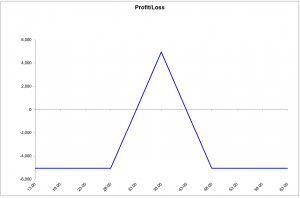An Iron Butterfly Spread on Shares of Canopy Growth Corporation

As you can see in the following graph, shares in Canopy Growth Corporation (WEED) have shot up in price since bottoming out at $6.58 in June 2017. This represents more than 600% growth to its recent peak at $44. Since then, WEED has slipped, falling to $29.50 before bouncing back and has been fluctuating in a range that could become a buffer zone for a while. If this is true, the situation could represent an opportunity to implement a strategy that takes advantage of the stock’s relative stability and, consequently, of the time decay of the option premium, which is very high right now with an implied volatility of over 80%.
Daily chart of WEED as at January 22, 2018 ($37.38)

Establishing an iron butterfly spread would allow us to profit from these conditions. It would not come as a surprise if the current pause turns out to be only temporary, so we choose an expiration of February 16, 2018.
Position
- Purchase of 10 call options WEED 180216 C 48 @ $0.50
- Debit of $500
- Sale of 10 call options WEED 180216 C 38 @ $2.35
- Credit of $2,350
- Sale of 10 put options WEED 180216 P 38 @ $3.50
- Credit of $3,500
- Purchase of 10 put options WEED 180216 P 28 at $0.40
- Debit of $400
- Total credit of $4,950
- Total credit of $4,950
- Debit of $400
Profit and Loss Diagram for the Iron Butterfly Spread

As you can see in the above diagram, we will make a maximum profit of $4,950, derived from the total net credit received, if WEED closes exactly at the strike price of $38 when our options expire on February 16, 2018. This position will be profitable as long as the price of WEED stays within the two breakeven prices of $33.05 and $42.95. The strategy will generate losses on either side of these two breakeven prices, with a maximum loss of $5,050 below the strike of $28 and above the strike of $48. The maximum loss is the difference between the strikes of the call options and the put options less the net premium per share, multiplied by the size of 100 shares per contract and by the position of 10 contracts: ($10 – $4.95) x 100 x 10.
Intervention
In taking this position, we are counting on the stock price being relatively flat for a period of time, but there are no guarantees that this will occur. So as long as WEED stays between the two above-mentioned breakeven prices, we do not need to intervene in any way. However, should the price break through either of these levels in a major way, we would be in a precarious position and exposed to potentially large losses. Such a situation would force us to take defensive measures, closing the position and absorbing the loss.
Good luck with your trading, and have a good week!
The strategies presented in this blog are for information and training purposes only, and should not be interpreted as recommendations to buy or sell any security. As always, you should ensure that you are comfortable with the proposed scenarios and ready to assume all the risks before implementing an option strategy.
President
Monetis Financial Corporation
Martin Noël earned an MBA in Financial Services from UQÀM in 2003. That same year, he was awarded the Fellow of the Institute of Canadian Bankers and a Silver Medal for his remarkable efforts in the Professional Banking Program. Martin began his career in the derivatives field in 1983 as an options market maker for options, on the floor at the Montréal Exchange and for various brokerage firms. He later worked as an options specialist and then went on to become an independent trader. In 1996, Mr. Noël joined the Montréal Exchange as the options market manager, a role that saw him contributing to the development of the Canadian options market. In 2001, he helped found the Montréal Exchange’s Derivatives Institute, where he acted as an educational advisor. Since 2005, Martin has been an instructor at UQÀM, teaching a graduate course on derivatives. Since May 2009, he has dedicated himself full-time to his position as the president of CORPORATION FINANCIÈRE MONÉTIS, a professional trading and financial communications firm. Martin regularly assists with issues related to options at the Montréal Exchange.
The information provided on this website, including financial and economic data, quotes and any analysis or interpretation thereof, is provided solely for information purposes and shall not be construed in any jurisdiction as providing any advice or recommendation with respect to the purchase or sale of any derivative instrument, underlying security or any other financial instrument or as providing legal, accounting, tax, financial or investment advice. Bourse de Montréal Inc. recommends that you consult your own advisors in accordance with your needs before making decision to take into account your particular investment objectives, financial situation and individual needs.
All references on this website to specifications, rules and obligations concerning a product are subject to the rules, policies and procedures of Bourse de Montréal Inc. and its clearinghouse, the Canadian Derivatives Clearing Corporation, which prevail over the content of this website. Although care has been taken in the preparation of the documents published on this website, Bourse de Montréal Inc. and/or its affiliates do not guarantee the accuracy or completeness of the information published on this website and reserve the right to amend or review, at any time and without prior notice, the content of these documents. Neither Bourse de Montréal Inc. nor any of its affiliates, directors, officers, employees or agents shall be liable for any damages, losses or costs incurred as a result of any errors or omissions on this website or of the use of or reliance upon any information appearing on this website.
BAX®, CADC®, CGB®, CGF®, CGZ®, LGB®, MX®, OBX®, OGB®, OIS-MX®, ONX®, SCF®, SXA®, SXB®, SXF®, SXH®, SXM®, SXO®, SXY®, and USX® are registered trademarks of the Bourse. OBW™, OBY™, OBZ™, SXK™, SXJ™, SXU™, SXV™, Montréal Exchange and the Montréal Exchange logo are trademarks of the Bourse. All other trademarks used are the property of their respective owners.
© 2024 Bourse de Montréal Inc. All Rights Reserved.
